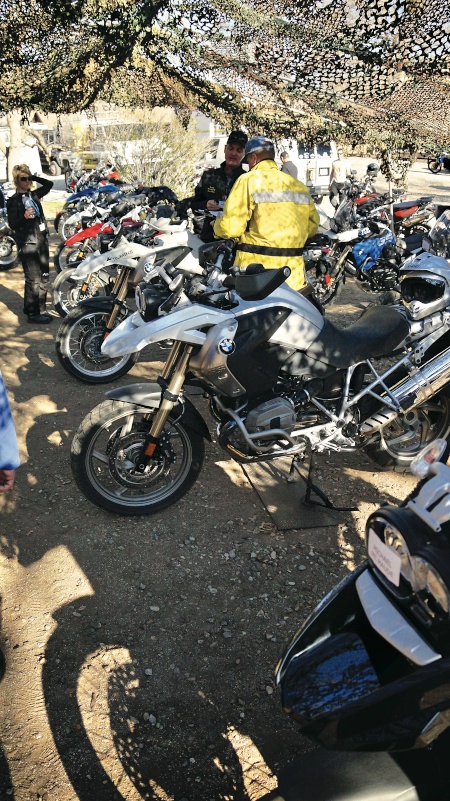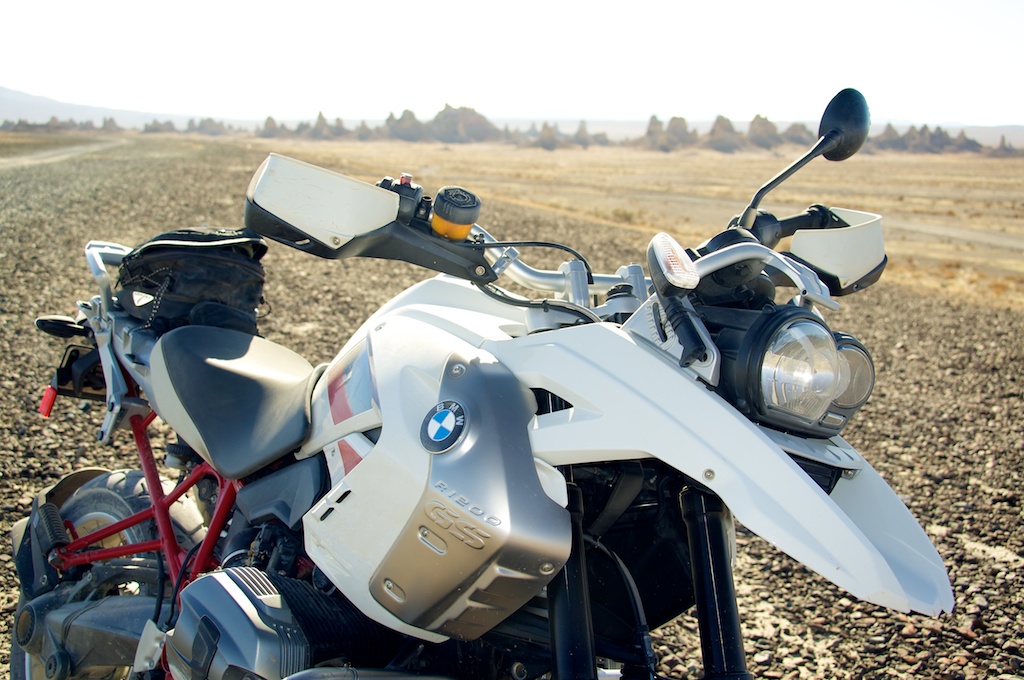
The rear tire of my 1200GS drifted in a slow arc, the stock Tourance rear tire sweeping over the loose gravel. My right foot modulated the brake, just off threshold, regaining traction and bringing the 600-pound motorcycle into a momentary track-stand. My position was now 90-degrees from the original course of travel, the bike pivoting between two cones and aligned for the obstacle ahead. Feathering the clutch, I started the BMW rolling towards a 12-inch-tall log and a set of orange traffic cones lying on their sides. Building momentum, I began shifting my weight downward on the pegs, bending my knees while simultaneously compressing the front and rear suspension. Rolling on the throttle while pulling back on the handlebar brought the front wheel nearly a foot in the air, lofting it just at the lip of the log and suspending the massive adventure bike momentarily against gravity. I shifted my weight forward towards the handle bar, which flattened the bike’s trajectory and allowed the rear tire to just clear the log and cones—rider and motorcycle landing smoothly before transitioning to the next challenge.

While I do not consider myself an expert rider, I am particularly adept at paying attention to quality instruction. This desire to learn (and more importantly reduce having to pick up 600-pound motorcycles too often) resulted in a trip to the RawHyde school for their “Next Step,” intermediate-level, training program. My goal was to become more comfortable with the larger adventure bikes and augment some of my dirt bike experience (on light 250s) with a few more tools. The result far exceeded my expectation, By the end of the course I was riding single-tracks, lofting the front wheel, doing U-turns in sand, and drifting the bike like a slalom skier on long descents. This issue’s Skills installment focuses on the key components of the RawHyde curriculum—the good, the bad, and the really, really dirty.

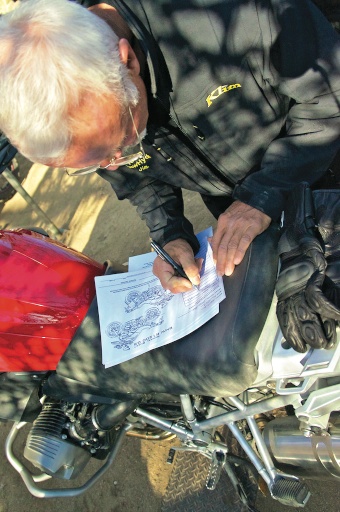
Benefits of Advanced Training
This article is the first in a series of skills columns that will focus on Best of Breed training offerings worldwide. The emphasis will be on curricula that reflect progressive approaches towards learning, each new skill building on the foundation of the prior. We will avoid programs taught by enthusiasts who lack a higher-education background, as practical knowledge of the subject alone rarely translates into an ability to educate. Admitting that we don’t know everything is the first step to perfection. The Overland Journal team is committed to, through formal training, continuously improving our skills as drivers and riders. The key: Get trained; practice often.
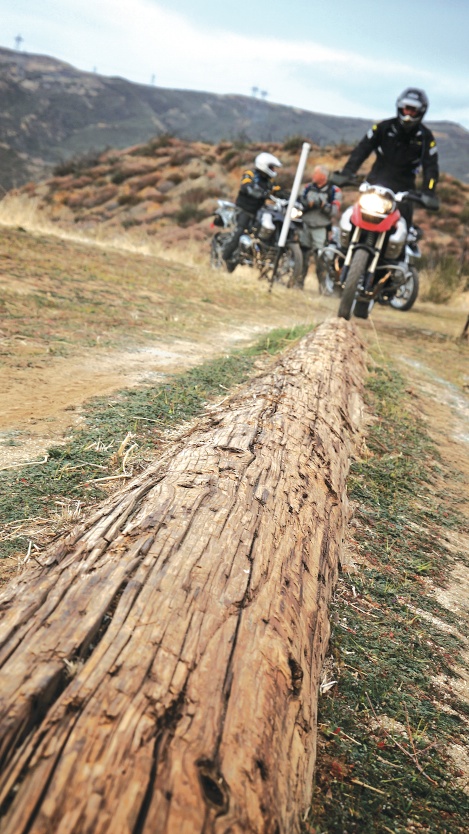
History of RawHyde
Exiting Interstate 5 near Castaic, California, and driving a few miles down a little-used section of tarmac frontage road, I came to the entrance of RawHyde. Turning left up a loose gravel road I was greeted with a sign stating, “Your adventure begins with our driveway.” I shifted my Power Wagon into four-wheel drive and made my way along a shelf road that wound through hills with tall grass and stunted oak trees. Every twenty yards, the trail was interrupted by a single-track exiting onto a steep descent, earthen mound, or sandy basin—I knew this training would be exactly what I was looking for. That was when Jim Hyde came puttering around the corner, his daughter sitting on the gas tank, the width of her smile nearly matching the handlebar. Jim greeted me and said, “We are on our daily daddy-daughter ride…see you in 30 minutes.”
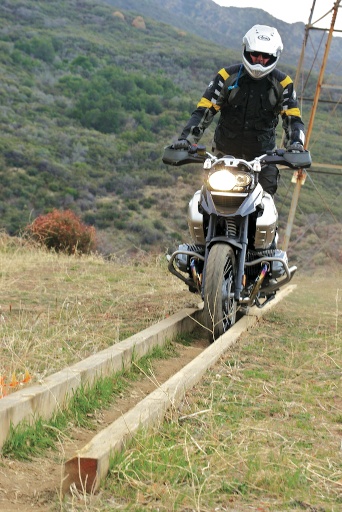
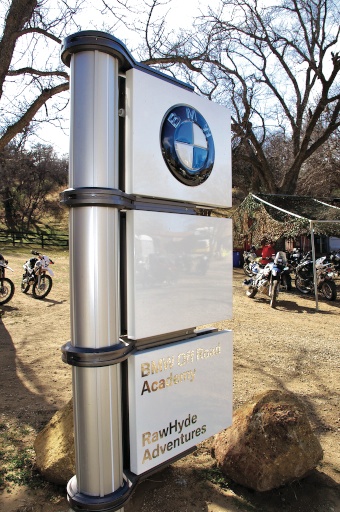
Jim started RawHyde Adventures, which he initially conceived as a Jeep tour company, in early 2002. Fortunately for those of us who want to improve our riding skills, that business model did not bear fruit and he quickly transitioned to adventure motorcycling, offering an eight-day dual-sport ride from Los Angeles to Las Vegas. The success of that original trip progressed into their acclaimed “Adventure Camp” program. By 2006, RawHyde was the number one enduro-training facility in the country; a position they have maintained since.
Mantra of a 600-Pound Dirt Bike
When riding Overland Journal’s KTM 950 Adventure, I am often asked “Can you really take that on the dirt?” The answer is a resounding “yes,” but only after you’ve learned the correct methods for riding a large adventure-class motorcycle in technical terrain. RawHyde emphasizes balance and control, but they start with the most critical of statements: “Slow down,” much like the Land Rover adage, “As slow as possible, as fast as necessary.” The larger bikes perform more consistently and effectively at a moderate pace. There are hundreds of techniques to learn, but the most critical is to slow the motorcycle down, temper your inputs, keep the machine in balance and the rider in control. Whether traversing a technical single track or negotiating luggage-deep sand, this concept remained universal throughout the training weekend. Slow down and maintain balance and control—make this your mantra.
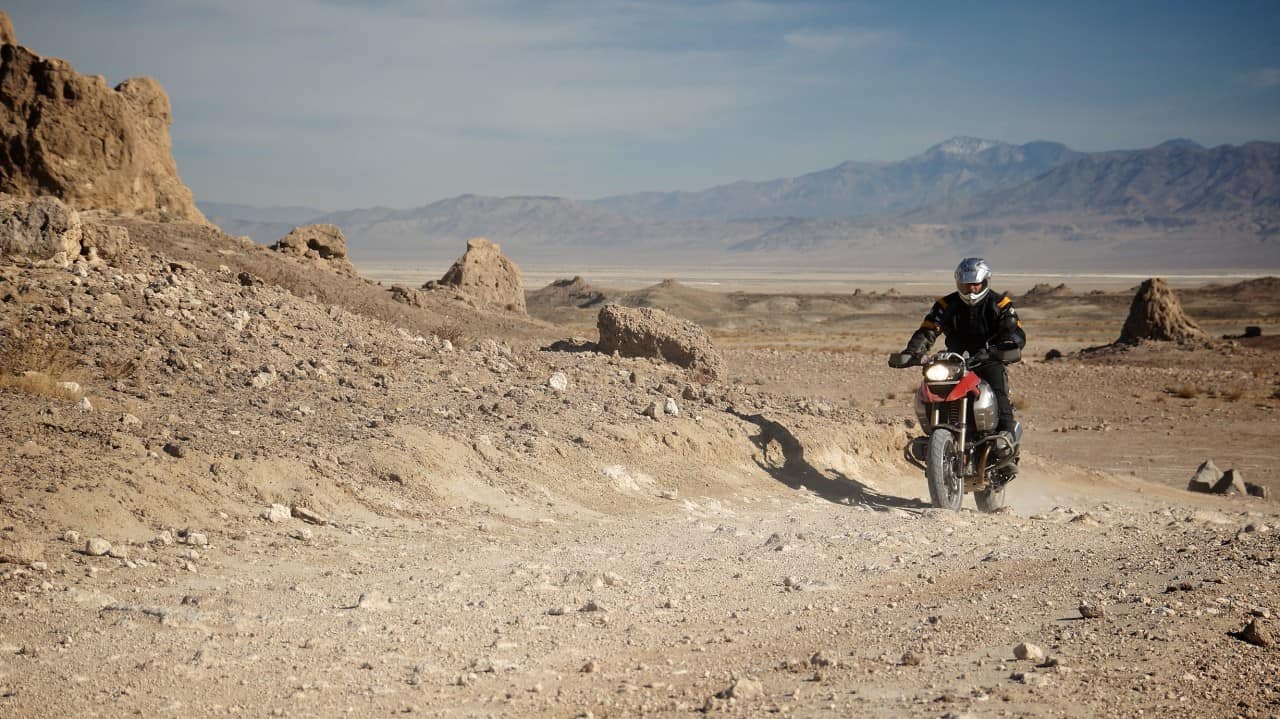
Secrets of ADV Riding
Waking from my small but comfortable sleeping quarters on the RawHyde property, I was greeted by several other students. We made our way to the dining hall, filled with the smell of pancakes and fresh coffee. Jim knows the three critical components of a successful guiding or training business: keep people well rested, well fed…and drunk. Of course, there was no drinking and riding, but they do have their own private-label wine, the GS (Grand Syrah). With a full belly I wandered over to the rows of near-new GS rental bikes, each with a name badge for one of the students. My bike proved to be a beautiful 30th Anniversary 1200GS with 16 miles on the odometer. Jim walked over, placed his hand on my shoulder, and said, “Enjoy the bike, but please don’t scratch it.” No pressure…

I was both fortunate and cursed by my fellow classmates, all friends from previous adventures and each eager to give considerable grief for the smallest bobble. Fortunately, I got embarrassment out of the way early by deploying my side stand into a soft patch of mud, then watching in horror as the pristine GS slowly listed into the grass. Dell, our skilled though somewhat reserved instructor, stepped in. I had provided the perfect opportunity for Dell to demonstrate techniques for lifting a fallen GS. Soon, all bikes were in the mud: Lay bike on side, lift, repeat.
Dell and the other instructors paid particular attention to ergonomics, ensuring that each rider received feedback on body position, hand position, and foot placement on the pegs. Here, I was wishing for a set of bar risers to better match my 6’1” height (I recommend bringing a set for the class). Prior to class, they took the time to rotate the handlebar up slightly, which helped. Building on this foundation of proper stance, we began implementing additional controls, starting with fine clutch modulation; rock the motorcycle forward slightly with engagement, then letting it roll backwards. Repeat. The key was to not stall the motor.
The remainder of the day was comprised of progressively more difficult control and balance tasks, starting with a tight series of turns between trees and on various cambered slopes. Our class learned quickly and Dell stepped up the pace, something we appreciated. This led to progressively steeper climbs and descents, all requiring optimal clutch and brake modulation to maintain traction.
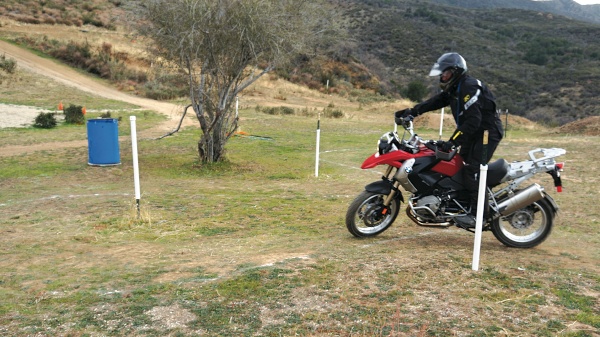
The Land of the Impossible
On day two we entered the land of the impossible, beginning with a warm-up ride on a number of single-track trails. Morning tasks included navigating incredibly steep slopes, jumping the big GSs over berms and logs, ascending near-vertical ledges, and dropping down loose ridges into tight, tree-lined routes. Dell queried the group for specific areas of concern or interest. We elected to spend several hours in the sand pit taking turns fighting the deep and merciless silica. Building on his earlier instruction, ergonomics and throttle control, Dell urged us to relax and get loose (ask him about Moisha). The idea was to let the bike move freely, within reason, while controlling direction with body position, pedal weighting, and throttle modulation. Within a few hours, we were not only crossing the sand pit proficiently, but doing U-turns and figure eights. The impossible was starting to feel probable.
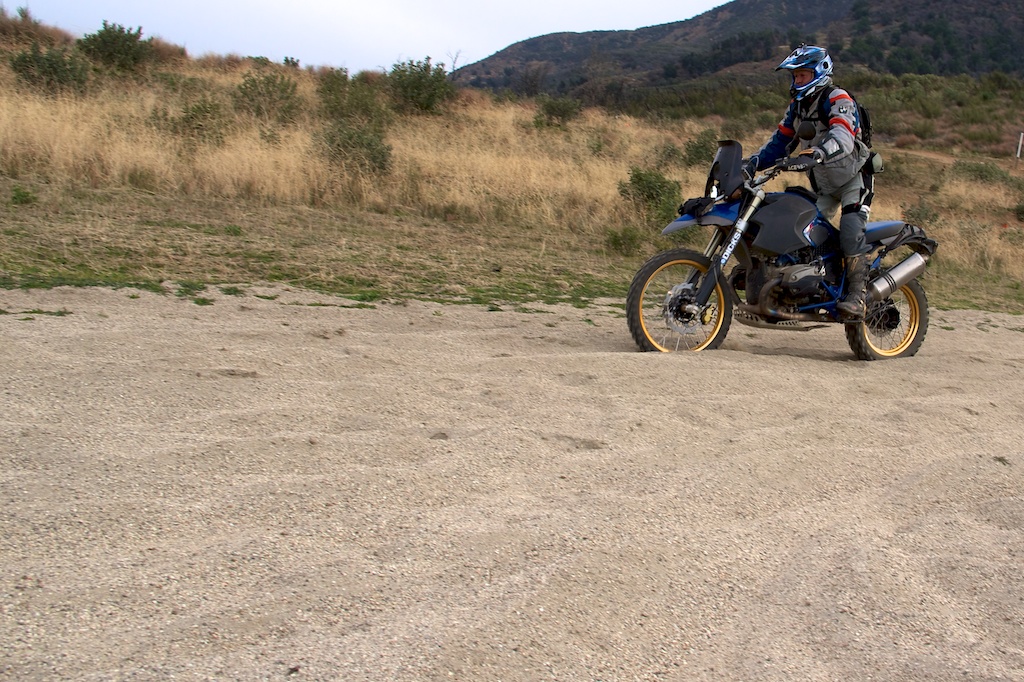
After lunch on our final day of instruction, Dell began the session with, “Do you guys want to learn to wheelie?” We responded with a resounding “Absolutely!” and proceeded to a nearly abandoned stretch of asphalt with a slight incline. The goal was, simply, to learn to loft the front wheel consistently over a series of painted white lines. This group, however, was feeling a bit smug. Within ten minutes we were trying to loft from line-to-line. Dell’s experience kicked in, knowing that leaving us to another minute of our own devices would certainly end in something disastrous.
We headed out to the single-track for a ride that would combine all of the technical skills we had learned in the days prior. We rode in perfect form, our hips shifting weight, our heads upright and guiding us on a precise line through the increasingly difficult track. Watching my friends effortlessly negotiate these challenges brought tremendous satisfaction to the conclusion of our training. We had all started with a “problem area” and ended as much more confident and capable riders. Though initially skeptical, I now see the great value in training with a totally stock GS. We were all shocked at what was possible with the Tourance street rubber.Moving to any smaller dual-sport, possibly with a more aggressive knobby tire, would simply amplify my newly acquired skills. With the sun setting on the RawHyde ranch, it was time to pack for Basecamp Alpha.
Basecamp Alpha
Basecamp Alpha is an add-on program to RawHyde’s Intro to Adventure and Next Step courses, and comprises a 340-mile adventure ride in the deserts of Southern California. The challenge of finding a moderately challenging, yet contiguous off-highway route resulted in quite a bit of gravel road and pavement miles. However, there were several significant highlights for me, principally the ride through the Trona Pinnacles and resulting torture-fest of a sand and whoop road. This road was horrible, but could not have been a better training ground for dealing with sand and loose gravel on a big bike. I was exhausted by the end of it, but felt completely comfortable with the GS moving actively under me.
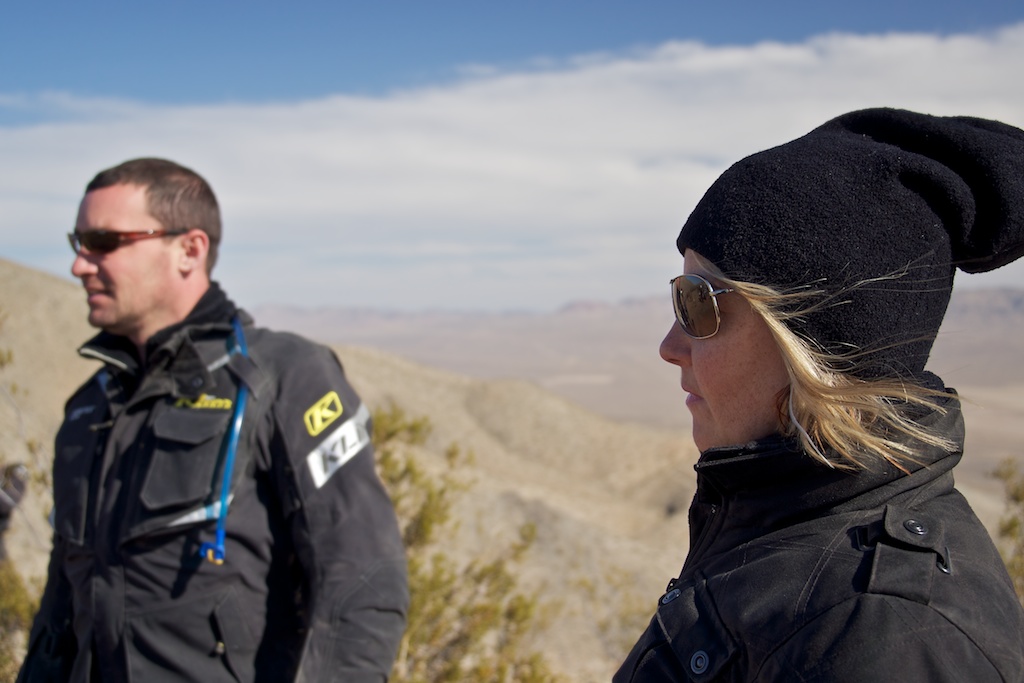
There was an opportunity for the group to split near the Burro Schmidt Tunnel. I joined the group taking a more technical route. It proved quite challenging, but nothing more difficult than Dell had pounded us with during the training. My only notable criticism was with an odd lunch stop on the Basecamp Alpha ride. With all of the beautiful desert detours available, I wondered why the parking lot of a Highway 395 gas station was the meal destination of choice (It could have been a logistics issue as the rest of the program was so tightly executed). The location of the Basecamp property also resulted in extensive road miles, which was nothing of a bother, but worth noting if considering this add-on.
In retrospect, the Basecamp Alpha ride is an important conclusion to the training, as it gets the rider into the field and combines so many of the learned skills in a natural environment. The miles of sand, two-track, and gravel road, reinforce the muscle memory and skills from the course. Remember, the sand road is for your own good—suck it up and own it.
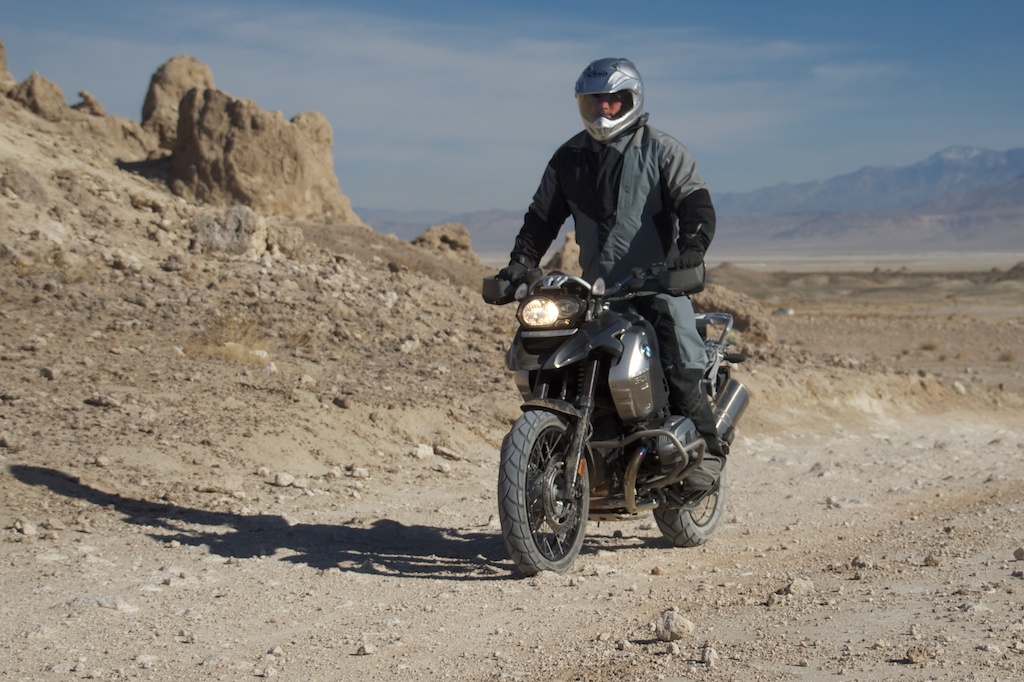
Conclusion
After a long weekend with the RawHyde team, I cannot speak highly enough of my experience and interaction with their staff. As a journalist, my goal is to be as critical as possible of each product and service I evaluate. However, in my nearly 20 years of adventure travel I have found few encounters that so markedly exceed my expectations. The RawHyde program is genuine and honest in delivery, all the while providing an exceptional learning environment and curriculum. My only criticisms, our lunch stop and few extra road miles, are admittedly petty given my overall impression. I arrived as an intermediate rider with limited confidence on the GS platform. I left as a more refined, accurate and controlled rider. Have you ever jumped a log with a 1200GS? I have, and it still makes me smile…
Five segments of the “Next Step” curriculum
By Jim Hyde
Step 1 – Proficiency
A rider must be autonomously proficient with the controls before they begin more difficult tasks. The first drills focus on rapid shifting and braking combined with acceleration, deceleration, skidding and turning exercises.
Step 2 – Finesse
This concept focuses on competencies like “slipping the clutch” to ease through tough obstacles, a momentary skid to help initiate a turn or change direction quickly at the bottom of a hill. Finesse also means avoiding the problems created by a heavy hand on the throttle.
Step 3 – Accuracy
Riding tight tracks ofin the backcountry leaves little room for maneuvering. Your ability to pick and hold a line is critical to becoming a better enduro rider. The path between two obstacles may be only be inches, or a series of ruts may leave very little room to navigate your way. Simply stated, your ability to hold a line is the difference between success and failure as a backcountry rider.
Step 4 – Total Control
Total control is not only about controlling your bike. It also pertains to your attitude, having a realistic perspective of your ability, and your physical conditioning. The practical side of our control drills focuses on higher-speed braking and turning, hill climbs and descents, and “single-track” exercises.
Step 5 – Confidence
The U.S. Army learned long ago that putting soldiers through an obstacle course did marvels for their confidence. RawHyde has developed a “confidence course” for just that purpose. Our “confidence course” is comprised of many challenges. A partial list includes: a series of jumps, half buried logs, exposed logs, narrow beams to be traversed, a boulders course, a giant teeter totter, and more. Once you have conquered the confidence course, the rest of the world is tame by comparison. The course is designed so you can study each obstacle, learn how to approach it, and then, after a demonstration from your instructor, you conquer it. You will find yourself “whooping” with satisfaction as you complete each challenge.
